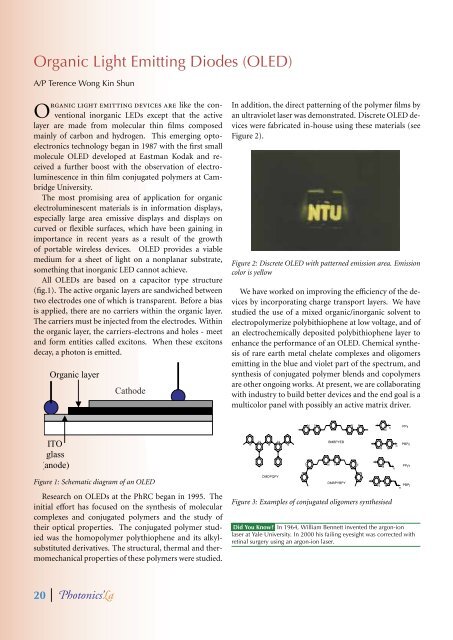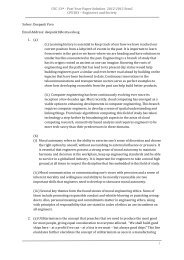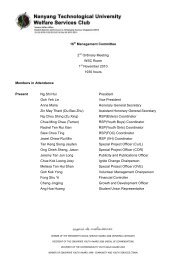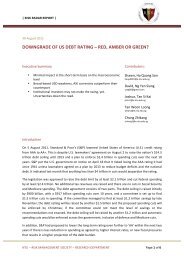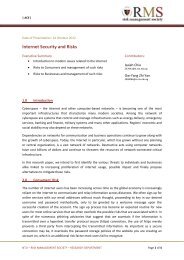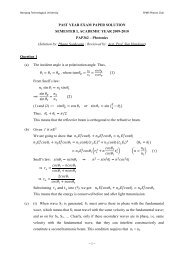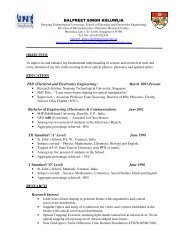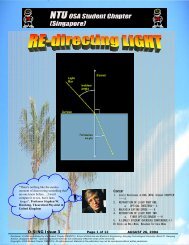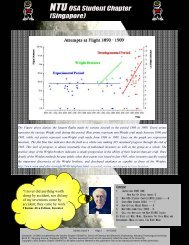PhRC NEWSLETTER PHOTONICS'La - Nanyang Technological ...
PhRC NEWSLETTER PHOTONICS'La - Nanyang Technological ...
PhRC NEWSLETTER PHOTONICS'La - Nanyang Technological ...
You also want an ePaper? Increase the reach of your titles
YUMPU automatically turns print PDFs into web optimized ePapers that Google loves.
Organic Light Emitting Diodes (OLED)<br />
A/P Terence Wong Kin Shun<br />
Organic light emitting devices are like the conventional<br />
inorganic LEDs except that the active<br />
layer are made from molecular thin films composed<br />
mainly of carbon and hydrogen. This emerging optoelectronics<br />
technology began in 1987 with the first small<br />
molecule OLED developed at Eastman Kodak and received<br />
a further boost with the observation of electroluminescence<br />
in thin film conjugated polymers at Cambridge<br />
University.<br />
The most promising area of application for organic<br />
electroluminescent materials is in information displays,<br />
especially large area emissive displays and displays on<br />
curved or flexible surfaces, which have been gaining in<br />
importance in recent years as a result of the growth<br />
of portable wireless devices. OLED provides a viable<br />
medium for a sheet of light on a nonplanar substrate,<br />
something that inorganic LED cannot achieve.<br />
All OLEDs are based on a capacitor type structure<br />
(fig.1). The active organic layers are sandwiched between<br />
two electrodes one of which is transparent. Before a bias<br />
is applied, there are no carriers within the organic layer.<br />
The carriers must be injected from the electrodes. Within<br />
the organic layer, the carriers-electrons and holes - meet<br />
and form entities called excitons. When these excitons<br />
decay, a photon is emitted.<br />
Organic layer<br />
ITO<br />
glass<br />
(anode)<br />
Cathode<br />
Figure 1: Schematic diagram of an OLED<br />
Research on OLEDs at the <strong>PhRC</strong> began in 1995. The<br />
initial effort has focused on the synthesis of molecular<br />
complexes and conjugated polymers and the study of<br />
their optical properties. The conjugated polymer studied<br />
was the homopolymer polythiophene and its alkylsubstituted<br />
derivatives. The structural, thermal and thermomechanical<br />
properties of these polymers were studied.<br />
20 hotonics'a<br />
In addition, the direct patterning of the polymer films by<br />
an ultraviolet laser was demonstrated. Discrete OLED devices<br />
were fabricated in-house using these materials (see<br />
Figure 2).<br />
Figure 2: Discrete OLED with patterned emission area. Emission<br />
color is yellow<br />
We have worked on improving the efficiency of the devices<br />
by incorporating charge transport layers. We have<br />
studied the use of a mixed organic/inorganic solvent to<br />
electropolymerize polybithiophene at low voltage, and of<br />
an electrochemically deposited polybithiophene layer to<br />
enhance the performance of an OLED. Chemical synthesis<br />
of rare earth metal chelate complexes and oligomers<br />
emitting in the blue and violet part of the spectrum, and<br />
synthesis of conjugated polymer blends and copolymers<br />
are other ongoing works. At present, we are collaborating<br />
with industry to build better devices and the end goal is a<br />
multicolor panel with possibly an active matrix driver.<br />
N<br />
N<br />
N<br />
N<br />
DMDPQPY<br />
N<br />
N<br />
N<br />
N N N N<br />
BMBPYEB<br />
N N N<br />
N<br />
DMBPYBPY<br />
( )<br />
n<br />
N<br />
( )<br />
n<br />
N N<br />
(<br />
(<br />
N<br />
N N<br />
Figure 3: Examples of conjugated oligomers synthesised<br />
)<br />
n<br />
PPy<br />
PBPy<br />
PPyV<br />
) PBPy<br />
n<br />
Did You Know? In 1964, William Bennett invented the argon-ion<br />
laser at Yale University. In 2000 his failing eyesight was corrected with<br />
retinal surgery using an argon-ion laser.


